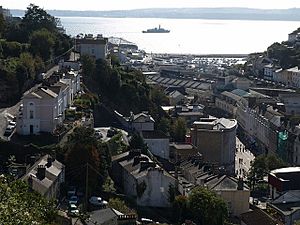Tor Bay facts for kids
Quick facts for kids Tor Bay |
|
|---|---|

A view north across Tor Bay from Brixham
|
|
| Lua error in Module:Location_map at line 420: attempt to index field 'wikibase' (a nil value). | |
| Location | South-east coast of Devon, England |
| Max. width | 4.5 mi (7.2 km) |
Tor Bay, sometimes called Torbay, is a beautiful bay on the south-east coast of Devon, England. It faces east towards the English Channel. The bay is about 4.5 miles (7.2 km) wide from north to south. Three towns, Torquay, Paignton, and Brixham, are located along its coast. Together, these towns are often called Torbay.
Contents
Understanding Tor Bay's Rocks
Tor Bay is surrounded by special rocks called Devonian limestone. These rocks form the northern edge at Hope's Nose and the southern edge at Berry Head. The types of rocks in this area are very different and interesting.
In 2007, the entire coastline of Tor Bay became part of the English Riviera Geopark. This means the area's geology is important and protected. It's like a natural museum of rocks and landforms!
How Tor Bay Changed Over Time
Long ago, during the last Ice Age, the sea level was much lower. At that time, Tor Bay was not covered by water. It was dry land! Scientists know this because they have found a submerged forest under the bay. This forest was once on dry land.
About 10,000 years ago, the sea level started to rise. This event is called the Flandrian transgression. The rising waters slowly covered the forest and turned the dry land into the bay we see today.
A Look Back at Tor Bay's Past
Tor Bay has always been a safe place for ships. It is protected from the strong winds that usually blow from the south-west. This made it one of the safest spots for ships between Land's End and the Isle of Wight.
In the 1600s, navy ships sometimes used the bay. They would gather there before sailing in groups. This use became much more common during the wars with France, which ended in 1815. However, if the wind suddenly changed to blow from the east, it could be dangerous for the ships.
A Famous Landing in Brixham
A very important event happened in Tor Bay on November 5, 1688. William of Orange landed his ships at Brixham. This landing was the start of the Glorious Revolution. This was a major change in how England was governed.
Boating and Fun in Tor Bay
Tor Bay has two safe harbours, one in Torquay and one in Brixham. Most of the bay offers good places for boats to drop anchor. It also gives great shelter from westerly winds.
Because the bay is so calm and protected, it's a very popular place for watersports. You can see people enjoying activities like sailing, paddleboarding, and kayaking here. There are also regular ferry boats that take passengers across the bay between Torquay and Brixham.


